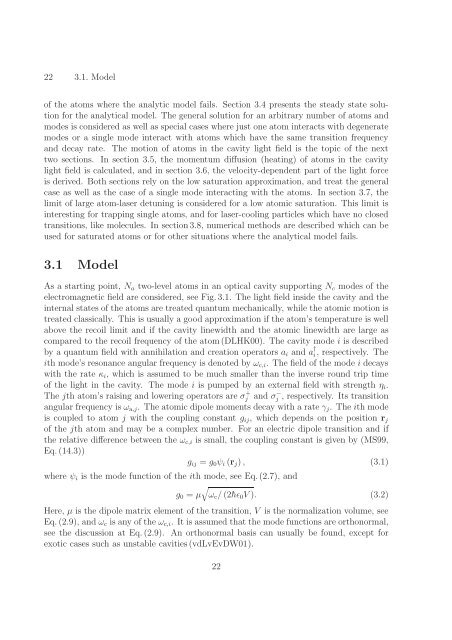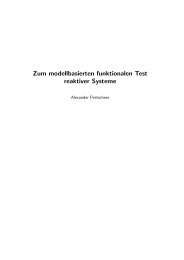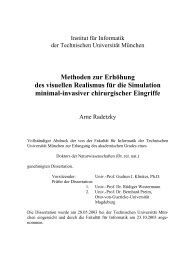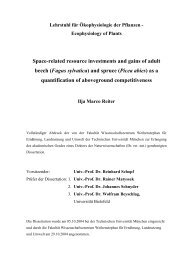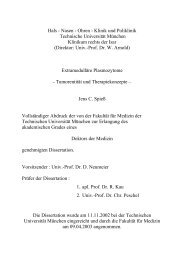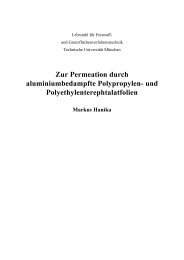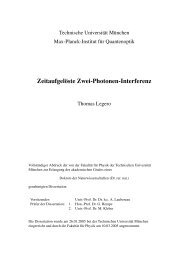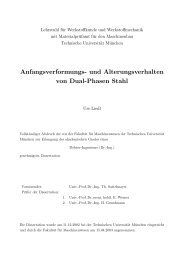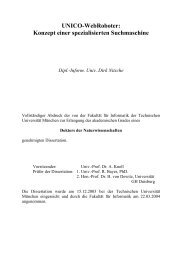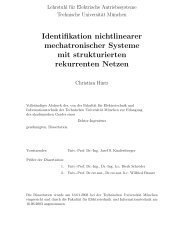Controlling the motion of an atom in an optical cavity
Controlling the motion of an atom in an optical cavity
Controlling the motion of an atom in an optical cavity
Create successful ePaper yourself
Turn your PDF publications into a flip-book with our unique Google optimized e-Paper software.
22 3.1. Model<br />
<strong>of</strong> <strong>the</strong> <strong>atom</strong>s where <strong>the</strong> <strong>an</strong>alytic model fails. Section 3.4 presents <strong>the</strong> steady state solution<br />
for <strong>the</strong> <strong>an</strong>alytical model. The general solution for <strong>an</strong> arbitrary number <strong>of</strong> <strong>atom</strong>s <strong>an</strong>d<br />
modes is considered as well as special cases where just one <strong>atom</strong> <strong>in</strong>teracts with degenerate<br />
modes or a s<strong>in</strong>gle mode <strong>in</strong>teract with <strong>atom</strong>s which have <strong>the</strong> same tr<strong>an</strong>sition frequency<br />
<strong>an</strong>d decay rate. The <strong>motion</strong> <strong>of</strong> <strong>atom</strong>s <strong>in</strong> <strong>the</strong> <strong>cavity</strong> light field is <strong>the</strong> topic <strong>of</strong> <strong>the</strong> next<br />
two sections. In section 3.5, <strong>the</strong> momentum diffusion (heat<strong>in</strong>g) <strong>of</strong> <strong>atom</strong>s <strong>in</strong> <strong>the</strong> <strong>cavity</strong><br />
light field is calculated, <strong>an</strong>d <strong>in</strong> section 3.6, <strong>the</strong> velocity-dependent part <strong>of</strong> <strong>the</strong> light force<br />
is derived. Both sections rely on <strong>the</strong> low saturation approximation, <strong>an</strong>d treat <strong>the</strong> general<br />
case as well as <strong>the</strong> case <strong>of</strong> a s<strong>in</strong>gle mode <strong>in</strong>teract<strong>in</strong>g with <strong>the</strong> <strong>atom</strong>s. In section 3.7, <strong>the</strong><br />
limit <strong>of</strong> large <strong>atom</strong>-laser detun<strong>in</strong>g is considered for a low <strong>atom</strong>ic saturation. This limit is<br />
<strong>in</strong>terest<strong>in</strong>g for trapp<strong>in</strong>g s<strong>in</strong>gle <strong>atom</strong>s, <strong>an</strong>d for laser-cool<strong>in</strong>g particles which have no closed<br />
tr<strong>an</strong>sitions, like molecules. In section 3.8, numerical methods are described which c<strong>an</strong> be<br />
used for saturated <strong>atom</strong>s or for o<strong>the</strong>r situations where <strong>the</strong> <strong>an</strong>alytical model fails.<br />
3.1 Model<br />
As a start<strong>in</strong>g po<strong>in</strong>t, Na two-level <strong>atom</strong>s <strong>in</strong> <strong>an</strong> <strong>optical</strong> <strong>cavity</strong> support<strong>in</strong>g Nc modes <strong>of</strong> <strong>the</strong><br />
electromagnetic field are considered, see Fig. 3.1. The light field <strong>in</strong>side <strong>the</strong> <strong>cavity</strong> <strong>an</strong>d <strong>the</strong><br />
<strong>in</strong>ternal states <strong>of</strong> <strong>the</strong> <strong>atom</strong>s are treated qu<strong>an</strong>tum mech<strong>an</strong>ically, while <strong>the</strong> <strong>atom</strong>ic <strong>motion</strong> is<br />
treated classically. This is usually a good approximation if <strong>the</strong> <strong>atom</strong>’s temperature is well<br />
above <strong>the</strong> recoil limit <strong>an</strong>d if <strong>the</strong> <strong>cavity</strong> l<strong>in</strong>ewidth <strong>an</strong>d <strong>the</strong> <strong>atom</strong>ic l<strong>in</strong>ewidth are large as<br />
compared to <strong>the</strong> recoil frequency <strong>of</strong> <strong>the</strong> <strong>atom</strong> (DLHK00). The <strong>cavity</strong> mode i is described<br />
by a qu<strong>an</strong>tum field with <strong>an</strong>nihilation <strong>an</strong>d creation operators ai <strong>an</strong>d a †<br />
i, respectively. The<br />
ith mode’s reson<strong>an</strong>ce <strong>an</strong>gular frequency is denoted by ωc,i. The field <strong>of</strong> <strong>the</strong> mode i decays<br />
with <strong>the</strong> rate κi, which is assumed to be much smaller th<strong>an</strong> <strong>the</strong> <strong>in</strong>verse round trip time<br />
<strong>of</strong> <strong>the</strong> light <strong>in</strong> <strong>the</strong> <strong>cavity</strong>. The mode i is pumped by <strong>an</strong> external field with strength ηi.<br />
The jth <strong>atom</strong>’s rais<strong>in</strong>g <strong>an</strong>d lower<strong>in</strong>g operators are σ + j <strong>an</strong>d σ − j , respectively. Its tr<strong>an</strong>sition<br />
<strong>an</strong>gular frequency is ωa,j. The <strong>atom</strong>ic dipole moments decay with a rate γj. Theith mode<br />
is coupled to <strong>atom</strong> j with <strong>the</strong> coupl<strong>in</strong>g const<strong>an</strong>t gij, which depends on <strong>the</strong> position rj<br />
<strong>of</strong> <strong>the</strong> jth <strong>atom</strong> <strong>an</strong>d may be a complex number. For <strong>an</strong> electric dipole tr<strong>an</strong>sition <strong>an</strong>d if<br />
<strong>the</strong> relative difference between <strong>the</strong> ωc,i is small, <strong>the</strong> coupl<strong>in</strong>g const<strong>an</strong>t is given by (MS99,<br />
Eq. (14.3))<br />
gij = g0ψi (rj) , (3.1)<br />
where ψi is <strong>the</strong> mode function <strong>of</strong> <strong>the</strong> ith mode, see Eq. (2.7), <strong>an</strong>d<br />
<br />
g0 = µ ωc/ (2¯hɛ0V ). (3.2)<br />
Here, µ is <strong>the</strong> dipole matrix element <strong>of</strong> <strong>the</strong> tr<strong>an</strong>sition, V is <strong>the</strong> normalization volume, see<br />
Eq. (2.9), <strong>an</strong>d ωc is <strong>an</strong>y <strong>of</strong> <strong>the</strong> ωc,i. It is assumed that <strong>the</strong> mode functions are orthonormal,<br />
see <strong>the</strong> discussion at Eq. (2.9). An orthonormal basis c<strong>an</strong> usually be found, except for<br />
exotic cases such as unstable cavities (vdLvEvDW01).<br />
22


